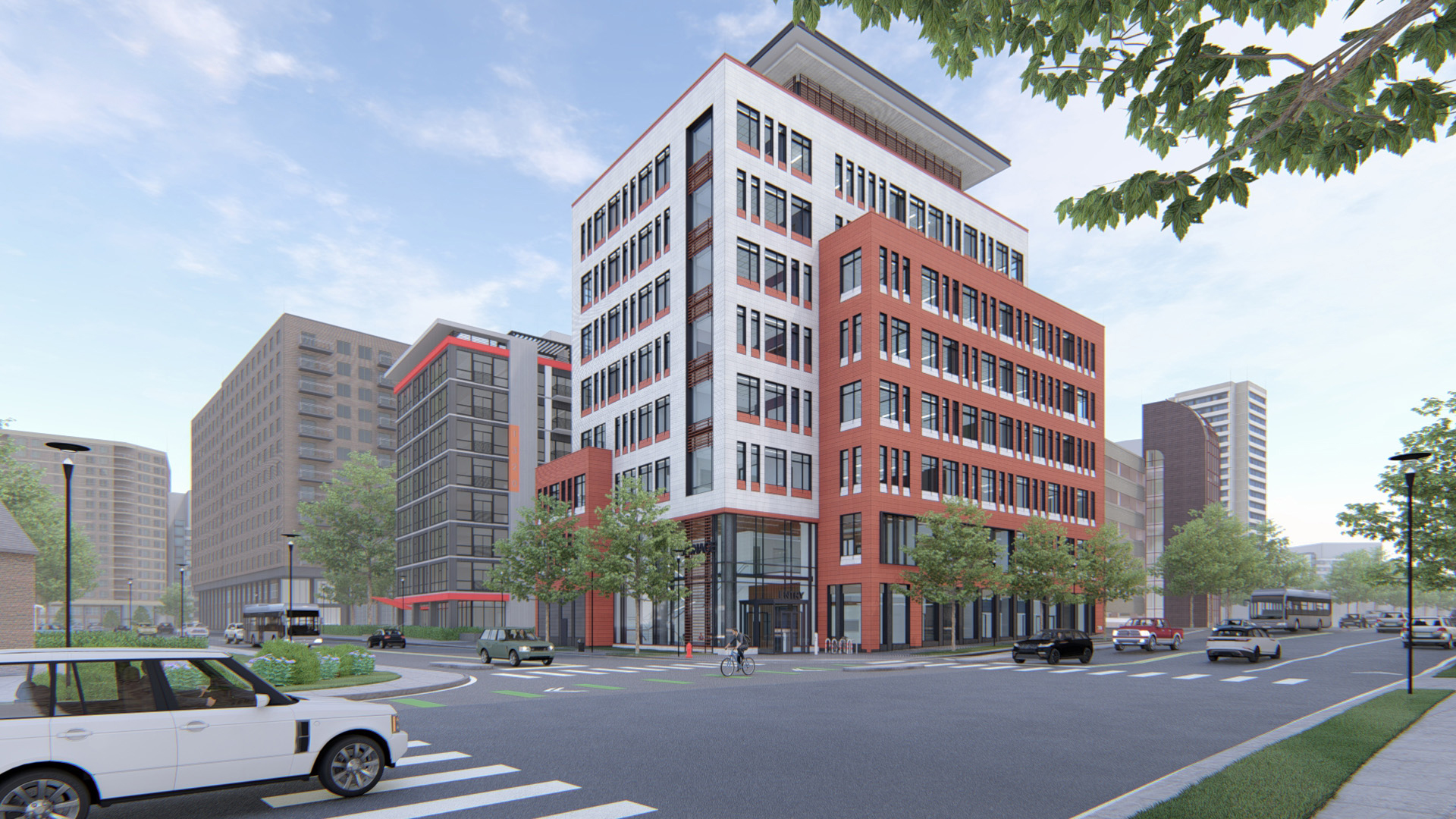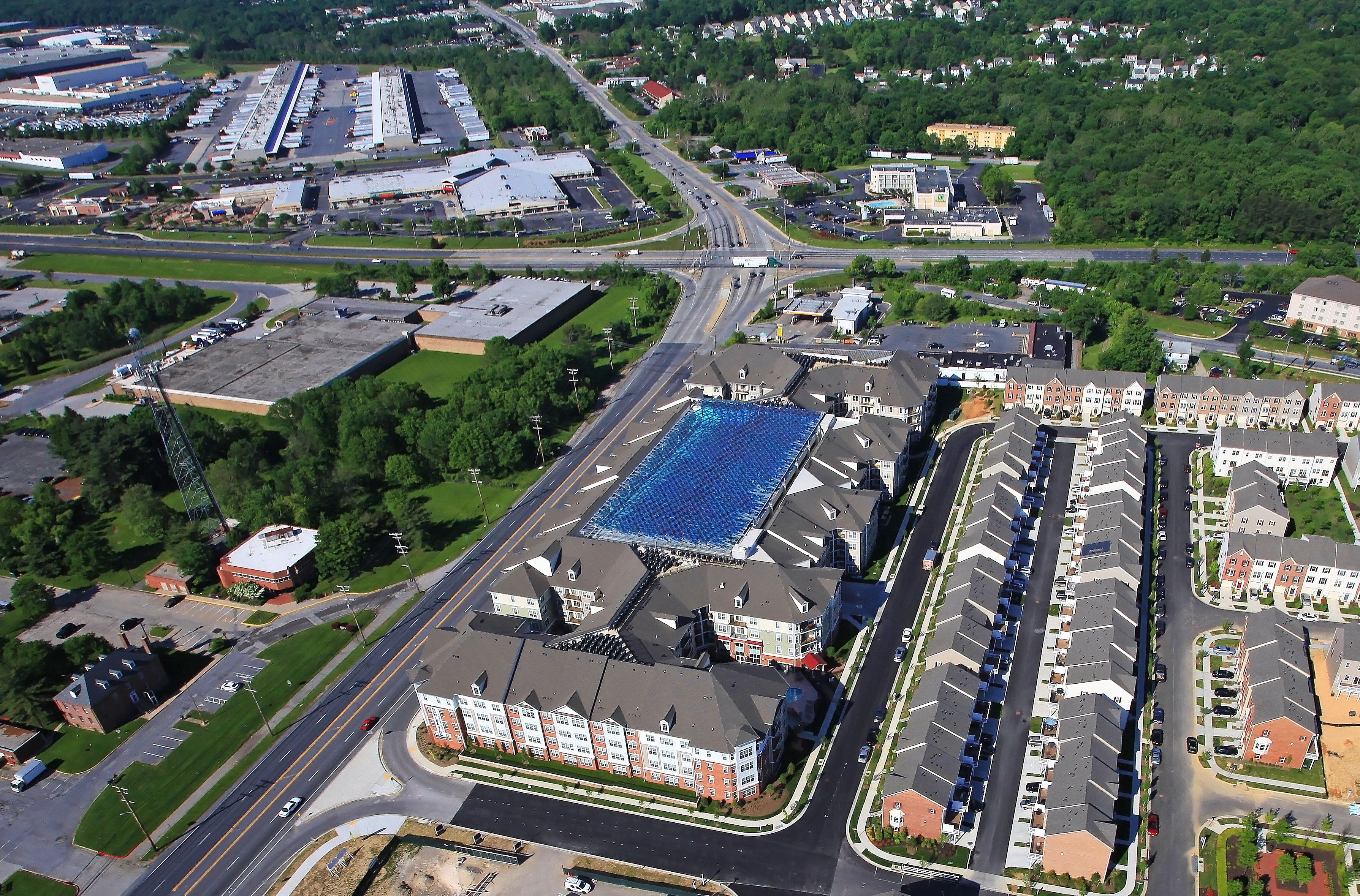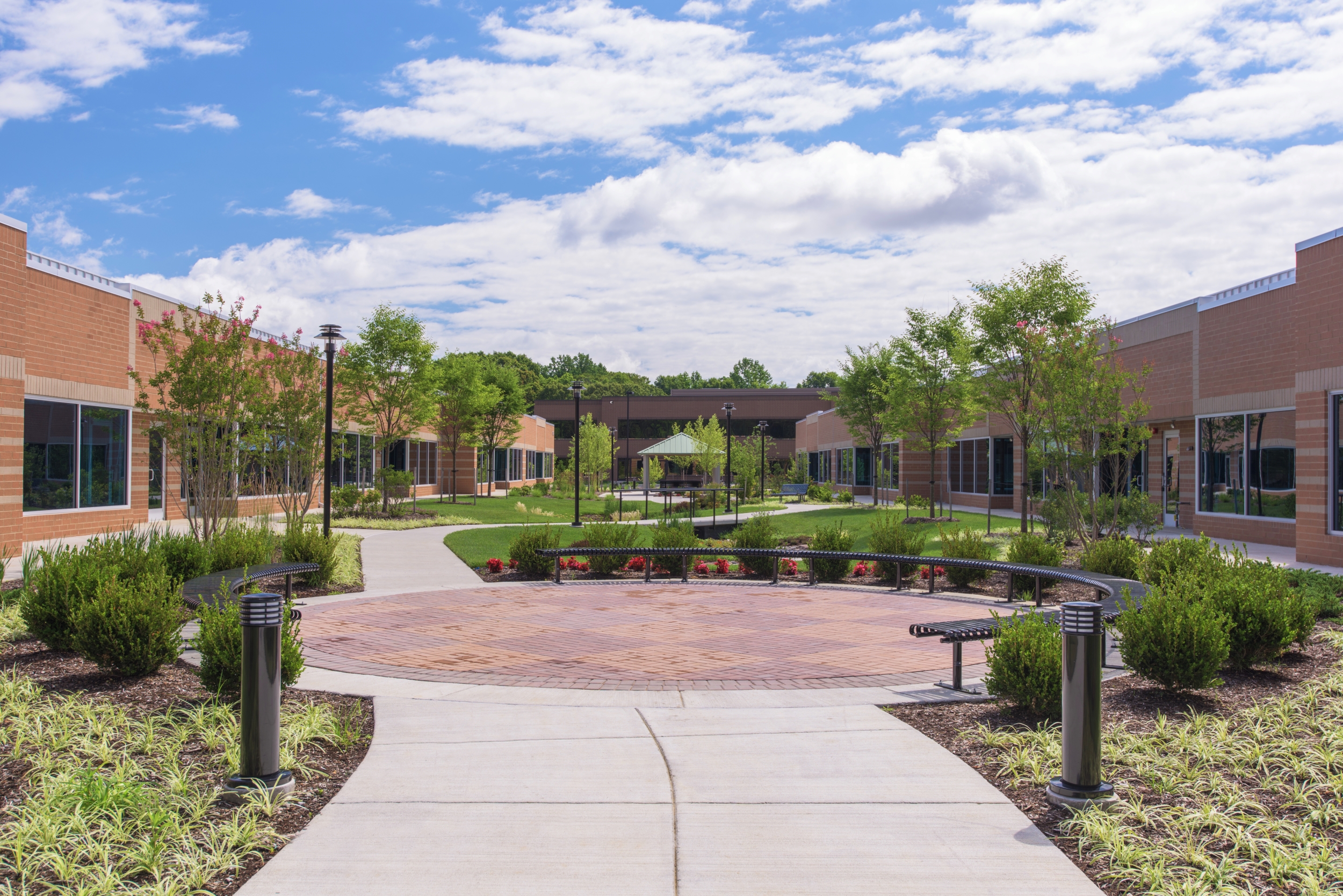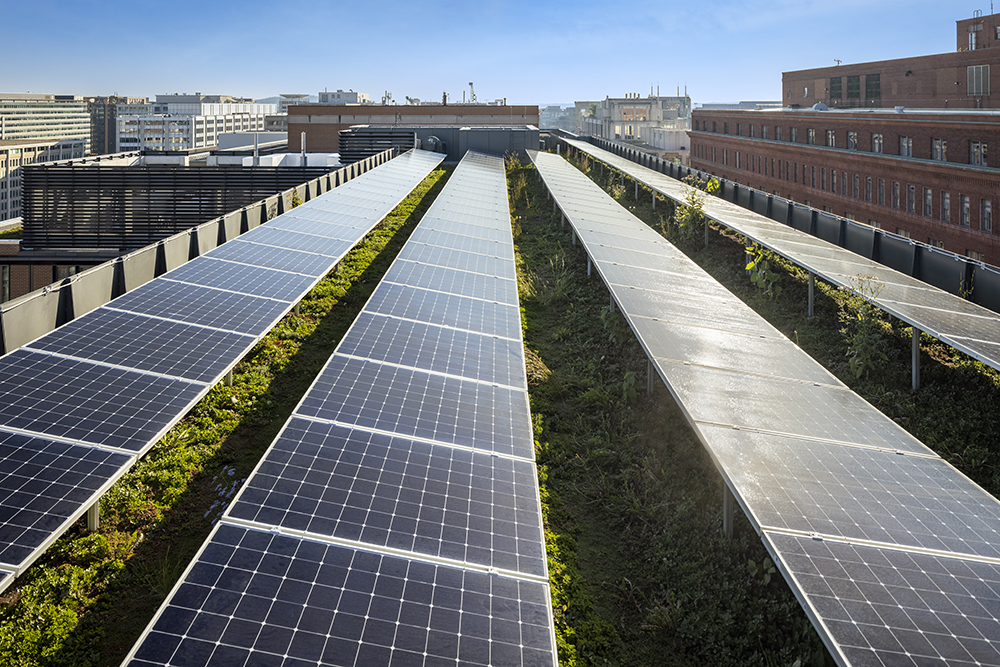In downtown Silver Spring, crews are preparing to break ground in December on an uncommonly sustainable building. The nine-story, 82,000-square-foot headquarters of the Housing Opportunities Commission of Montgomery County will be all-electric and net-zero-ready.

The new Housing Opportunities Commission building will be all-electric and net-zero-ready. Image courtesy of Design Collective.
“We are not putting any novel technology or anything experimental into the building. We haven’t added a lot of bells and whistles,” said Seonhee Kim, Director of Sustainability and Principal at Design Collective. “We are just using proven methods, optimizing the size of systems and doing careful space composition.”
The building’s design includes a high-efficiency variable refrigerant flow (VRF) heating/cooling system and an array of thermostats that enables occupants of individual offices to control their own temperature (and dissuades them from plugging in inefficient space heaters). An electrical dedicated outdoor air system (DOAS) with an energy recovery system will provide fresh air to the spaces. In addition to a tight envelope and footprint, the building will feature glazing that is designed to deliver natural light but manage solar heat gain. The glazing is also restricted to 40 percent of the exterior unlike many office buildings with all-glass façades.
The design and engineering team surveyed future occupants to determine usage patterns and power needs, ran numerous energy models to optimize design and equipment choices, and will complete building system and envelope commissioning.

A solar array over a parking structure satisfies nearly 42 percent of Verde East’s electricity needs. Image courtesy of Lorax Partnerships.
Once the building opens, it is projected to require 36-38 percent less energy than a comparable, conventional building and, with the purchase of Tier 2 offsite renewable energy, will be well prepared to achieve net zero status, Kim said.
While all-electric systems and building decarbonization remain daunting prospects, some construction projects are achieving remarkable sustainability and efficiency levels. Advances in technology, incentive programs by governments and utilities, and changes in market preferences are gradually shifting the standards for how much decarbonization is possible and affordable.
Green premiums
When the leaders of 28 Walker Development began planning a commercial building for The Collective at Canton, a mixed-use community in Canton, they opted to construct Baltimore’s first mass timber office building.
The construction method for 40TEN Boston would deliver a building with dramatically lower embodied carbon. Constructing the top three floors from mass timber rather than concrete slabs and columns prevented the production of 7.8 million pounds of carbon dioxide, said David Wilson, Assistant Project Manager at Chesapeake Contracting Group. In addition, timber’s natural ability to sequester CO2 offset the CO2 generated in the production of the podium and foundations, making 40TEN a carbon neutral structure. 28 Walker chose design elements and building systems to improve 40TEN’s energy efficiency and lower the carbon impact of its operations.
“We invested heavily in a remarkable glazing system that would improve tenants’ experience in the building and lower their HVAC bills,” said Scott Slosson, Chief Operating Officer at 28 Walker Development.
The electrochromic glazing provides ample daylight inside the space but automatically alters its tint to avoid overheating the space in summer and allow solar gain in winter. The system which consumes about the same power as 58 60-watt lightbulbs, lowers the 115,000-square-foot building’s cooling load by about 23 percent, Wilson said.
The building’s high-efficiency, under-floor, air-distribution system delivers conditioned air closer to occupants and “allows physics to take care of your air return and supply since hot air naturally rises,” Wilson said.

Live-work-play environments and buildings that can flex to accommodate future uses are part of St. John Properties holistic sustainability plan. Image courtesy of St. John Properties.
An energy-recovery ventilator in the building’s daycare lowers the HVAC load for that space by roughly 50 percent. Meanwhile, LED lighting, low-flow plumbing fixtures and efficient rooftop units further improve the building’s performance. Although the developer did not seek LEED certification for the project, Wilson calculates 40TEN could meet the requirements for LEED Platinum. Those sustainability and efficiency gains came at a cost. Mass timber alone typically costs 10-15 percent more than conventional construction.
“With money, you can do whatever you want. We also realized that in Baltimore, at some point, you hit a ceiling in what rents can be,” said Mark Sapperstein, Chief Executive Officer of 28 Walker Development. “But we wanted to spend the money and create this cool, signature building that people would be proud to come into.”
Today, 40TEN is nearly 70 percent leased and “we have never heard a push back on rent,” Sapperstein said.
Leasing rates, which are in the mid-$30s per square foot, “have more than justified the spend,” Slosson said.
Across its portfolio of high-efficiency buildings, including approximately 100 LEED Silver and Gold facilities, St. John Properties has also realized a healthy return on its investment.
“Over the past 15 years, St. John Properties has successfully scaled our sustainability program, making the premium for efficient buildings more than worthwhile,” said Ryan Schwabenbauer, Assistant Vice President, Sustainability.
St. John’s current standard includes sustainable shell buildings with solar panels, white roofs, efficient glass, LED lights and efficient HVAC systems.
“Our investments in efficiency offer real energy cost savings. The return in energy costs year after year for our tenants is considerable, making us a better long-term partner,” Schwabenbauer said.
St. John Properties has started “thinking more holistically about sustainability,” he said. The company is “moving more toward building mixed-use communities where people can live, work, and play without having to drive far… We also see versatility as a key factor in sustainable building. Given that the building demolition and construction process is very carbon intensive, we want to ensure that the buildings we create today can stand the test of time. We accomplish this with sustainable shell buildings featuring flexible interiors that can be retrofitted to serve a wide variety of purposes as the economy evolves.”
New incentives and technology
An expanded array of federal, county and utility incentives has shifted the calculation on what sustainability measures are financially viable.

Government incentives have improved the economics of rooftop solar, enabling some projects to achieve full ROI in one year. Image courtesy of Lorax Partnerships.
Baltimore, Howard, Montgomery and Prince George’s counties all offer substantial property tax credits for buildings that achieve certain efficiency and decarbonization goals. For example, a new Montgomery County development can qualify for a 25 percent credit if it achieves LEED Gold and a 75 percent credit for achieving LEED Platinum, said Tim Barranco, Principal and Sustainability Director at Lorax Partnerships. A separate tax credit which is not connected to building certification, provides an additional 25 percent credit to buildings that demonstrate major energy savings.
“So really high performing projects will get 100 percent property tax credit for four years,” Barranco said. “That could be well over $1 million in savings on larger multifamily projects. It is enough to fund design improvements so developers are willing to put solar on the roof and make other design changes that wouldn’t happen without this program.”
For example, Verde East at Howard Square in Elkridge achieved LEED Platinum certification. The development which includes 17,000 square feet of ground-level retail space and 344 residential units, includes a solar photovoltaic array with a capacity of 444,004 kWh/year – enough to provide 42.4 percent of the building’s energy needs.
The incentives and sustainability improvements, however, stretch beyond multifamily projects. Incentives have made LEED Gold financially attractive on many commercial projects and greatly improved the payback from rooftop solar installations on some industrial and self-storage centers.
The Inflation Reduction Act (IRA) enhanced federal 179D tax rebates which cover energy efficiency measures in commercial buildings, and converted some rebates into tax deductions that can be applied to three years of back taxes, said Casey Ross, Director of Energy Services at Lorax. Consequently, buildings can qualify for tax incentives of $1 to $1.80 per square foot, or up to $5 per square foot of HUD Zone properties.
The IRA also solidified a 30 percent federal tax credit for solar panel installations for the next 10 years.
“The economics of solar are better than ever,” Barranco said. “Generally for commercial properties, the payback period on solar is now in the three to six year range.”

Mass timber construction upped the cost of developing 40TEN Boston but also attracted tenants who are willing to pay premium rates. Image courtesy of Chesapeake Contracting Group.
However, the addition of solar can move a property to a higher level of LEED certification, triggering county property tax credits and enabling some solar installations to realize full return on investment within a year, Barranco said. “If you are building commercial in Baltimore, Howard, Montgomery or Prince George’s County and you have roof space for solar and you are not doing solar, you are missing out on a huge property tax savings.”
Designers and engineers also stress that the sustainability measures that are possible and financially viable in commercial properties keep shifting due to advances in technologies and changing prices.
“I really wanted to get ‘green concrete’ in the mix [for 40TEN Boston],” Wilson said. Although the product was too pricey at the time, “if we were to reprice it today, the green concrete is actually a cost savings depending on the mix design.” The cost of all-electric building systems has fallen to roughly par with more conventional gas systems, Barranco said.
A Variable Refrigerant Flow (VRF) system which may have been cost prohibitive less than a decade ago, became the efficient and affordable option for the Montgomery County Housing Opportunities Commission building. Yet the project team which designed the building two years ago, likely would have selected different technology – namely a heat pump – if they were designing the building today, Kim said. “The tide is turning. Now, technology is taking off for the cold-weather heat pump system.”
Sustainable projects for government and academic clients, Kim added, are steadily generating new insights on how to effectively and affordably decarbonize buildings.